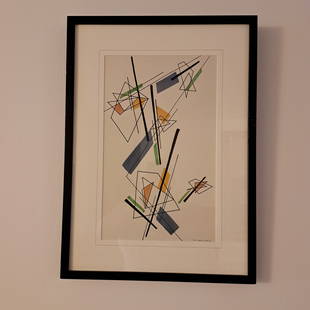
An Art Nouveau Hand Carved Marble Alabaster Figural Lamp, Italy, Circa 1910
Similar Sale History
View More Items in Militaria & War Memorabilia
Related Militaria & War Memorabilia
More Items in Art Nouveau Militaria & War Memorabilia
View MoreRecommended Collectibles
View More













Item Details
Description
An Art Nouveau Hand Carved Marble Alabaster Figural Lamp. The lamp is finely carved in the shape of a fountain with flying cupid angels holding flowers. Under the cupids is a carved satyr that water comes out of his mouth and flows down to a small pond. Italy, Circa 1910 Unidentified Signature. Numbers & Made Italy The lamp is in a working condition. 25"X13"X8" _____________________________________________________________ Art Nouveau is an international style of art, architecture, and applied art, especially the decorative arts. The style is known by different names in different languages: Jugendstil in German, Stile Liberty in Italian, Modernisme in Catalan, and also known as the Modern Style in English. It was popular between 1890 and 1910 during the Belle Époque period, and was a reaction against the academic art, eclecticism and historicism of 19th century architecture and decoration. It was often inspired by natural forms such as the sinuous curves of plants and flowers. Other characteristics of Art Nouveau were a sense of dynamism and movement, often given by asymmetry or whiplash lines, and the use of modern materials, particularly iron, glass, ceramics and later concrete, to create unusual forms and larger open spaces. One major objective of Art Nouveau was to break down the traditional distinction between fine arts (especially painting and sculpture) and applied arts. It was most widely used in interior design, graphic arts, furniture, glass art, textiles, ceramics, jewellery and metal work. The style responded to leading 19-century theoreticians, such as French architect Eugène-Emmanuel Viollet-le-Duc (1814–1879) and British art critic John Ruskin (1819–1900). In Britain, it was influenced by William Morris and the Arts and Crafts movement. German architects and designers sought a spiritually uplifting Gesamtkunstwerk ("total work of art") that would unify the architecture, furnishings, and art in the interior in a common style, to uplift and inspire the residents. The first Art Nouveau houses and interior decoration appeared in Brussels in the 1890s, in the architecture and interior design of houses designed by Paul Hankar, Henry van de Velde, and especially Victor Horta, whose Hôtel Tassel was completed in 1893. It moved quickly to Paris, where it was adapted by Hector Guimard, who saw Horta's work in Brussels and applied the style to the entrances of the new Paris Métro. It reached its peak at the 1900 Paris International Exposition, which introduced the Art Nouveau work of artists such as Louis Tiffany. It appeared in graphic arts in the posters of Alphonse Mucha, and the glassware of René Lalique and Émile Gallé. From Belgium and France, Art Nouveau spread to the rest of Europe,[citation needed] taking on different names and characteristics in each country (see Naming section below). It often appeared not only in capitals, but also in rapidly growing cities that wanted to establish artistic identities (Turin and Palermo in Italy; Glasgow in Scotland; Munich and Darmstadt in Germany), as well as in centres of independence movements (Helsinki in Finland, then part of the Russian Empire; Barcelona in Catalonia, Spain). By 1914, with the beginning of the First World War, Art Nouveau was largely exhausted. In the 1920s, it was replaced as the dominant architectural and decorative art style by Art Deco and then Modernism. The Art Nouveau style began to receive more positive attention from critics in the late 1960s, with a major exhibition of the work of Hector Guimard at the Museum of Modern Art in 1970.
Buyer's Premium
- 23% up to $2,500,000.00
- 20% up to $2,500,001.00
- 12% above $2,500,001.00
An Art Nouveau Hand Carved Marble Alabaster Figural Lamp, Italy, Circa 1910
Estimate $4,000 - $6,000
2 bidders are watching this item.
Shipping & Pickup Options
Item located in Pasadena, CA, usSee Policy for Shipping
Local Pickup Available
Payment
Accepts seamless payments through LiveAuctioneers

TOP

























![[CIVIL WAR]. Folk art carved pipe identified to the 3rd Pennsylvania Cavalry, referencing Colonel: [CIVIL WAR]. Folk art carved pipe identified to the 3rd Pennsylvania Cavalry, referencing Colonel W.W. Averell and battles fought in 1862. Oversized folk art carved wooden pipe, approx. 5 1/2 in. over](https://p1.liveauctioneers.com/197/250551/130130055_1_x.jpg?height=310&quality=70&version=1654185975)
![[CIVIL WAR]. Folk art carved pipe identified to Orren Clark Richards, 3rd Massachusetts Light: [CIVIL WAR]. Folk art carved pipe identified to Orren Clark Richards, 3rd Massachusetts Light Artillery. Folk art carved wood pipe, medium brown in color, overall width 3 1/2 in., bowl height 3](https://p1.liveauctioneers.com/197/250552/130130502_1_x.jpg?height=310&quality=70&version=1654186071)

















![Relics for Sale Vicksburg Battlefield: Relics for Sale. Park View Before Work was Commenced. Albumen photograph on cardstock mount. [Vicksburg, Mississippi]: C.L. Longley, ca 1900. Printed orange label to mount verso with photographer's in](https://p1.liveauctioneers.com/7226/325455/175169039_1_x.jpg?height=310&quality=70&version=1712370394)
![Prisoner in Italian concentration camp for women: Heading: Author: (Judaism - Holocaust) Title: Eisenstein, Maria Place Published: L'Internata Numero 6: Donne fra i reticolati del campo di concentramento Publisher:Roma [i.e. Rome] Date Publishe](https://p1.liveauctioneers.com/642/326037/175553772_1_x.jpg?height=310&quality=70&version=1713477451)















![George Washington Signed Discharge: Partly printed discharge document signed by George Washington, as Commander in Chief of the Armies of the United States. Newburgh, [New York], 4 January 1783. 1 page, ## x ## in. Undersigned by Washin](https://p1.liveauctioneers.com/7226/322253/173251475_1_x.jpg?height=310&quality=70&version=1710004847)

![[Ambrotype] Texas Confederate Soldier: Sixth plate ambrotype. Full leatherette case. Portrait of a possible Texas Confederate soldier. A silver star device was used to pin up the brim of his light-toned headgear, a look often seen in image](https://p1.liveauctioneers.com/7226/322253/173251509_1_x.jpg?height=310&quality=70&version=1710004847)




